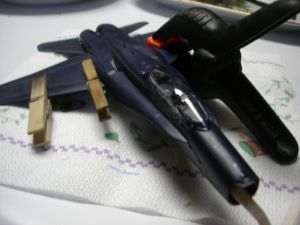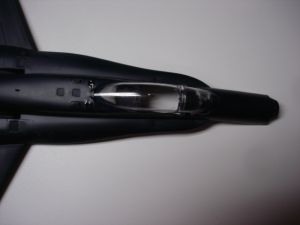Modification 1/48 F-18 Hornet Blue Angel Plastic Model Conversion
Scratch - 1/48 F-18 Hornet Blue Angel
Contributed by Kyle James Yawn
| Manufacturer: | Scratch |

Brief:
This is a plastic model conversion of the Revell 1/48 scale model of the F-18 Hornet Blue Angel. This was the first plastic model conversion I had ever attempted and would not have done so if it were not for the EMRR 2006 Challenge. It was a lot of fun putting this rocket together.
Modifications:
To begin construction, I glued the engine blocks inside the motor mount tubes using a spent engine casing and allowing 1/8" of the motor to stick out the back. After this dried, I took the bottom half of the plastic body and laid these two tubes inside of it where they pressed up against the plastic stop in the middle of the body. They hung out slightly from the two engine holes in the back. I aligned these until I thought they were in the straightest and best looking place and then used 15 minute epoxy to hold them in that place. I did this by just pouring the epoxy around the motor tubes at both ends. I allowed some of the epoxy to flow down inside the forward ends of the tubes to better hold them in place. Just be sure to have room in the tubes for the ejection charges to escape. I then cut an Estes style shock cord mount out of a piece of paper and used epoxy to attach this just aft of the forward landing gear well. The small gap between this landing gear area and the inner wall was a great place for the shock cord to come through and it gave it added strength.
 While this was setting up on the lower half, I next worked on the upper half of the body. The only really work that had to be done was the placement of the cockpit windows so the ejection charges could not leak out through the hole in the upper body section. First, the small U-shaped plastic piece was epoxied in place around the area where the cockpit chair would have been placed. Next, the two clear windows were epoxied on over this and epoxy was placed between them to be sure to seal all gaps.
While this was setting up on the lower half, I next worked on the upper half of the body. The only really work that had to be done was the placement of the cockpit windows so the ejection charges could not leak out through the hole in the upper body section. First, the small U-shaped plastic piece was epoxied in place around the area where the cockpit chair would have been placed. Next, the two clear windows were epoxied on over this and epoxy was placed between them to be sure to seal all gaps.
After these two sections were set, the rear horizontal fins were put it place. There is a plastic bar connecting the two which must be cut. I left a small portion of this bar on both fins so these could be placed through the holes in the sides of the body and epoxied to the motor mount tubes. I then placed epoxy on the bottom edge of this fin and attached it to the bottom half of the plastic body tube.
 Next the two halves are put together. I covered the seam in epoxy all the way around and applied liberal amounts of in on the wing areas. I was afraid that the two halves may come apart during flight or due to the ejection charge. I then used strong clamps on each wing to hold it all together flush.
Next the two halves are put together. I covered the seam in epoxy all the way around and applied liberal amounts of in on the wing areas. I was afraid that the two halves may come apart during flight or due to the ejection charge. I then used strong clamps on each wing to hold it all together flush.
Once that was dry, I used epoxy to attach the vertical fins. I just placed the epoxy on the bottom edge and on the tabs and slid them into the slot.
The trickiest part was getting the nose cone to work. I wanted to use the one that came in the plastic kit but it has no shoulder. I decided to make one using two small pieces of balsa wood. I epoxied them to the inside of the nose cone with half of each piece sticking out. Once it dried, I shaved off pieces of each one until it finally fit snuggly on the top of the rocket. I then used another Estes style shock cord mount to attach the other end of the shock cord, and tied a streamer to the cord near the nose cone.
Construction:
These are the parts I used for this plastic model conversion:
- Both main halves of the plastic body
- The 4 plastic fins from the kit
- The plastic nose cone from the kit
- The two clear sections of the cockpit
- The plastic base of the larger cockpit window.
- Two 4.875" long 13mm motor mount tubes
- Two 13mm engine blocks
- One 1/8" launch lug
- One 10" long elastic shock cord
- Two small scrap pieces of 1/8" balsa wood
- One 12" long streamer
There are 6 fins total on this rocket, the two main fins which are part of the plastic body, the two vertical fins on the rear, and the two horizontal fins on the rear. No centering rings were needed for construction. The nose cone and shock cord are attached with epoxy and Estes style shock cord mounts.
Well only 9 of the 70+ parts from the actual plastic kit were used. I thought about putting some detailed stuff on it such as the landing gear, but I figured that it might crash and all that effort go to waste anyway so why bother. I'm sure it would look pretty nice with all the bells and whistles on it though.
The motor mount was small for the size and weight of this rocket. If I went back and did it again I would have cut out part of the back end of the plastic casing and put in a 18mm cluster rather than a 13mm one. Also since there are no centering rings for the tubes, they need to be aligned perfectly by sight for the cluster to work properly.
This is a pretty quick build if you are using 5 or 15 minute epoxy and it looks nice. I chose to wait until I had test flown it before adding any decals or fancy things to it, so for it's flight it was just the plain blue plastic it came looking as. The clear cockpit does make it look nice though and allows the recovery system to be seen as well.


Flight and Recovery:
Well I used two A10-3Ts for this rocket, but if I had to recommend motors, these are way too small. The motors are friction fit, so I just wrapped a piece of masking tape around the middle of both of them. This worked fine. Insert the two motors and add some wadding then pack the streamer and put on the nose cone. I used a clip whip for ignition, but I'm sure twisting the ignitor leads together would work just as well.
The flight never gained any significant altitude. Both motors lit and it took off straight up to maybe about 40 feet high. It then flopped back down and crashed. After it had been on the ground, the ejection charge fired. It landed not 5 feet from the pad though. Upon further inspection, the two plastic halves split at their epoxy joint all the way down the rocket on one side. I'm not sure if this is due to the crash or the ejection charge or maybe both.
The recovery system deployed on the ground just fine however. I was slightly worried that the streamer would get stuck. I think this rocket would need a small parachute if it could get one out before it hit the ground.
Summary:
PROs: Quick build, plastic model conversion, scale model of a NAVY fighter, and it is a cluster rocket.
CONs: Way underpowered, needs buffed up construction to stay together, and needs larger motor mounts.
I had great fun building and flying (or crashing) this rocket. It was a great experience to try something new which I otherwise would not have. I enjoyed it and learned to pay a bit more attention to my motor selection on any more scratch built rockets I have in the future.
 |
 |
Sponsored Ads
 |
 |












Steve Lindeman (August 12, 2014)
Just curious what the final weight of the rocket was without motors. I would have thought 2 A's would have been sufficient power but again that would depend on weight. Nice conversion nonetheless.